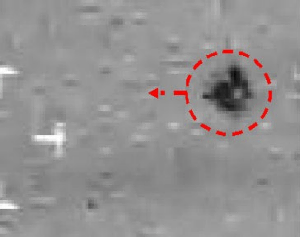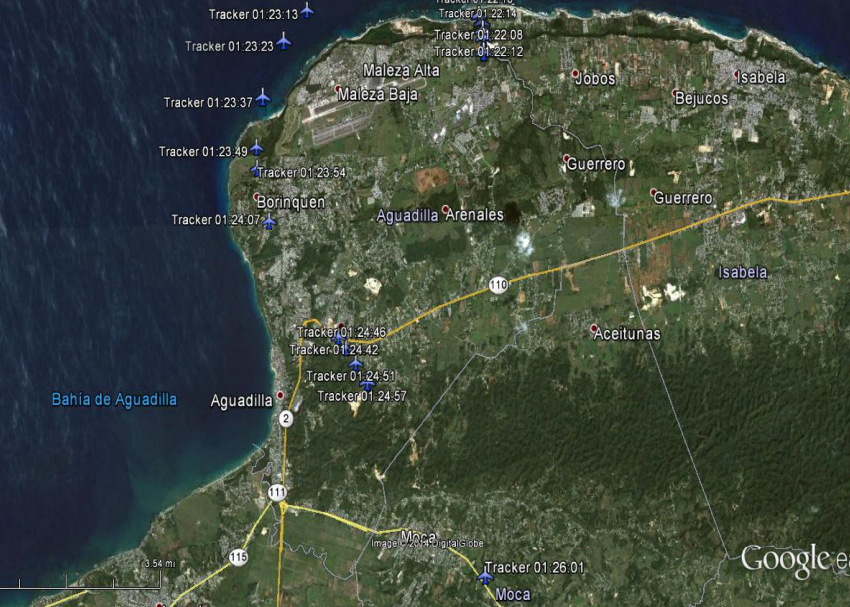
Summary
The Aguadilla, Puerto Rico event occurred at around 9.20 pm on April 25, 2013 and is regarded as one of the best-recorded sightings of Unidentified Aerial Phenomena (UAP). The event occurred around Rafael Hernandez airport, Aguadilla, located on Puerto Rico’s north-western tip.
In the 3 minute 54 second video¹², a small object can be seen moving above the ocean and land. Although filmed at night, the object appears to manoeuvre through residential areas and trees and enters the Atlantic Ocean (without slowing down) before splitting into two separate objects,
The Aguadilla UAP was an object spotted by a U.S. Customs and Border Protection (which falls within the Department of Homeland Security) De Havilland Canada (DHC) 8 Turboprop aircraft.
A copy of the video was obtained from an unknown official source on October 20, 2013, who was, according to the Scientific Coalition for UFOlogy (SCU), was vetted and identified.³
The SCU obtained the footage and in an analytical report, which accompanied public release of the video, referred to it as ‘the best documentation of an unknown aerial and submerged nautical object exhibiting advanced technology that the authors of this report have ever seen.’
In addition to the video, witness statements and radar data have corroborated details regarding the event.
The SCU concluded the UAP to be of unknown origin, adding that ‘there is no explanation for an object capable of travelling under water at over 90 mph with minimal impact as it enters the water, through the air at 120 mph at low altitude through a residential area without navigational lights, and finally to be capable of splitting into two separate objects.’⁴
Case Details

At around 9.20 pm on April 25, 2013 a UAP of unknown origin approached from the Atlantic Ocean (from the north) before travelling directly over the Rafael Hernandez Airport runway in Aguadilla, Puerto Rico, delaying the departure of a commercial aircraft. As stated by the SCU report, the UAP then re-crossed the airport’s runway on its way out to sea, again heading north.
There was no squawking transponder signal to alert the airport tower, nor was there any communication with the tower to prevent danger to arriving and departing aircraft from the airport.
An airborne U.S. Customs and Border Protection (CBT) aircraft captured a thermal imaging video, showing irregular characteristics of the UAP, which according to a SCU report⁵, were not similar to any known natural or man-made objects.
The pilot of the CBT aircraft claims to have seen a pinkish to reddish light over the ocean, northwest of the airport, through his left window. According to the pilot, the light was moving towards the airport and he believed it to be higher than his own aircraft, which was around 1600 to 2100 feet.
The pilot confirmed visual contact with tower personnel, who also confirmed visual contact. As the object approached the shore, its light ‘went out’.⁶ At that moment, the pilot requested monitoring of the craft with the on-board surveillance equipment.
The aircraft’s on-board radar equipment did not detect the object, according to the pilot, but its thermal imaging equipment did. Whilst being seen through the thermal imaging equipment, the pilot did not have visual contact with the UAP. The pilot also confirmed that no attempt was made to intercept the UAP, nor did the object seem to react to the CBT aircraft.
Another witness, whose identity is not known, claimed that the UAP caused the delay of commercial aircraft from the airport. This witness also said that the thermal infrared video showing the UAP was widespread within a CBP office.
Furthermore, the witness said that United States Air Force (USAF) Intelligence was contacted and provided with a copy of the video. USAF Intelligence, according to the witness, offered no explanation for the UAP and recommended other agencies to contact, whose identities are not known.
Analysis
The case was analysed in detail by the SCU in a report authored by Robert Powell, Morgan Beall, Larry Cates, Carl Paulson, Richard Hoffman and Daina Chaviano. Together, the authors used their combined expertise (including in physics, engineering, mathematics, data analysis, information technology) and experience (some had backgrounds in defense and worked on advanced technology and engineering) to rigorously analyse the case and associated data.
To assist its analysis the SCU obtained radar data from the USAF 84th Radar Evaluation Squadron through a Freedom of Information Act (FOIA) request, which supports the validity of the video. Furthermore, the radar data validates the times and locations displayed on the thermal imaging equipment of the CBT aircraft.
Additionally, radar data showed other ‘unknown target(s) over the ocean and two to three miles to the north and northwest of the Rafael Hernandez airport were detected,’⁷ and that none had transponders.
Furthermore, the object’s properties were compared (by the SCU) against all known possible explanations, including drone technology.
According to the SCU’s report:
‘The object’s speed, maintenance of momentum, directional changes, and its ability to sustain high velocities in water eliminates all aircraft, blimps, balloons, wind-blown objects, any species of bird, mamma; or other natural / man-made phenomena.’
The SCU collected a witness statement, which also states that the CBT aircraft and control tower saw a UAP moving from the ocean to the south.
Thermal analysis of the infrared video conducted by the SCU⁸ revealed ‘irregular characteristics of an unknown object not similar to any known natural of man-made objects.’
Through analysis, the SCU was able to determine the size and speed of the UAP at points in the video when the locations of the object could be identified. The SCU calculated that the object was between three to five feet in length and that its speed varied between approximately 40 mph to 120 mph.⁹ Analysis found that its median speed was roughly 80 mph.
Furthermore, the object appeared to pass through the ocean water from the air without its speed being affected. Its speed through the water reached as high as 95 mph and averaged 82.8 mph. According to the SCU the lack of significant deceleration* as it entered the water, despite the absence of an identifiable power supply, is difficult to explain. The object is also noted as ‘apparently’ accelerating while underwater, according to the SCU report.
There was very limited interaction with the water visible through the infrared video when the UAP impacted the ocean. However, analysis by the SCU found there might be a slight wave or movement of water when the UAP entered the ocean.
As the SCU analysis states, it is unknown ‘if the U.S. or another nation has developed the ability to diminish water displacement caused on impact.’
Despite reaching speeds up to 120 mph and making multiple changes in direction, entering the ocean and splitting into two parts, there is no evident exhaust plume or any indication of an aircraft. Although (through studying the infrared thermal video) the UAP appears to emit more heat than the ambient air, the SCU found there were no characteristics associated with objects using ordinary power sources.
The SCU analysis report notes that the object appears to be tumbling whilst moving through the air, providing a non-aerodynamic appearance – the tumbling actions end prior to it entering the ocean and as it moves through the water.
It is noted by the report that the object’s ‘ability to fly at altitude at night and between trees requires precise control of movement and a highly responsive propulsion system particularly given the lack of control by aerodynamic devices.’¹⁰
*Meaning significant deceleration as an unpowered object, such as a bullet striking the water
Witnesses
According to the SCU report¹¹, there were two witnesses: ‘Witness A’ and ‘Witness B’. Witness A is referred to as an officer and pilot employed by the CBP division of Homeland Security, who was pilot of the aircraft and one of the crew members that witnessed the UAP.
Witness B wishes to remain anonymous, although did act as the point of contact for Witness A. The SCU provided both witnesses questionnaires as the organisation sought to investigate the case.
Other Sightings
According to the SCU report, Witness A indicated that another CBP pilot witnessed a formation of ‘pinkish / red lights flying extremely low over the airfield in an unusual flight pattern’¹² east of the base and 15 to 30 minutes before Witness A’s own sighting. Witness A also reported that the primary witness’s** son saw a light similar to the UAP caught on video exit and enter the ocean off the Puerto Rico coast and north of the airport ‘one or two evenings after the main event on April 25, 2013.’¹³
**’Primary witness’, meaning the pilot and crew of the CBP aircraft
Release Of Video
The video was submitted to the SCU in November 2013.¹⁴
According to SCU Board Member and Public Relations Director, Alejandro Rojas,¹⁵ research commenced after an acquaintance of the CBP pilot contacted Daina Chaviano, a Cuban-born fantasy science fiction writer who was a volunteer with the Mutual UFO Network (MUFON) in Florida.
Chaviano took the case to her MUFON colleague, Morgan Beall, who ran the Florida MUFON chapter. Chaviano and Beall were very impressed with what they were presented with and assembled a group of sceptical researchers with backgrounds in science and technology.
The report (from the group of sceptical researchers) and video were released publicly by the SCU in August 2015.
The SIGMA2 Study
The French Astronautical and Aeronautical Association’s¹⁶ (AAAF) technical committee, known as 3AF-SIGMA2, conducted its own study¹⁷ into the case, and the two prosaic possibilities it presented were not definitive and elements of the case could not be completely explained.
The first possibility was of an object such as a lantern pushed by the wind. Although, its thermal signature would appear weak and its occultations could not be explained under this scenario.
The second possibility presented was micro or mini drones propelled by gas nozzles or micro turbines, but whose existence in 2013 was not proven.